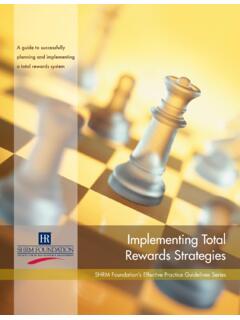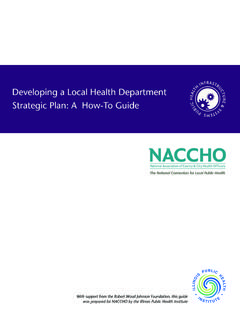Transcription of OECD Toolkit for Mainstreaming and Implementing …
1 1 . OECD Toolkit for Mainstreaming and Implementing Gender EqualityImplementing the 2015 OECD Recommendation on Gender Equality in Public Life . 2 .. 3 . Table of ContentsCHAPTER 1: INTRODUCTION .. p. Why an OECD Toolkit for Mainstreaming and Implementing Gender Equality? .. p. How does the Toolkit work? .. p. Who is the Toolkit for? .. p. 5 CHAPTER 2: INSTITUTIONAL AND GOVERNANCE FRAMEWORKS FOR GENDER EQUALITY AND Mainstreaming .. p. Whole-of- government strategic plan for Implementing gender equality .. p. Institutional mechanisms for gender equality and Mainstreaming .
2 P. Assessment of gender impacts of various public governance dimensions .. p. Integration of the gender perspective in all phases of the budget cycle .. p. Accountability for gender equality and Mainstreaming .. p. Measuring progress towards gender equality performance .. p. Complaint and appeal mechanisms to protect rights for gender equality .. p. 45 CHAPTER 3: GENDER SENSITIVE PRACTICES IN PARLIAMENTS .. p. Mainstreaming gender in internal parliamentary processes and practices .. p. Integrating a gender perspective in parliaments external oversight and accountability functions.
3 P. Achieving balanced representation of women and men in parliaments/legislatures at all levels .. p. 61 CHAPTER 4: GENDER SENSITIVE PUBLIC EMPLOYMENT SYSTEMS .. p. Enablers for gender-sensitive public employment systems .. p. Leadership and executive accountability for promoting gender equality in the public sector .. p. Gender-sensitive public employment systems .. p. Addressing gender wage gaps and occupational segregation .. p. 88 CHAPTER 5: GENDER SENSITIVE PRACTICES IN THE JUDICIARY .. p. A comprehensive framework for gender equality in judicial decision-making.
4 P. Measures to attract and recruit women and men from diverse backgrounds to judicial posts .. p. Fostering an enabling environment to retain and promote women and men from diverse backgrounds in judicial careers .. p. Monitoring the impact of gender equality initiatives in the judiciary .. p. 110 GLOSSARY OF TERMS .. p. 112 REFERENCES .. p. 120 . 4 . The 2015 OECD Recommendation of the Council on Gender Equality in Public Life (GEPL Recommendation) provides a clear path for making governments, public administrations, legislatures, and judiciaries more aware of and responsive to the perspectives, interests and needs of both women and men.
5 Making state institutions more sensitive to gender requires more than increasing the number of women in leadership positions. It means better understanding how formal and informal policies, practices and procedures across state institutions can reinforce gender inequalities and gender-based stereotypes, and what can be done to enable gender equality. The Toolkit guides policy makers in Implementing the GEPL Recommendation, helping them design gender-sensitive public policies and services and enable women s equal access to public decision Toolkit focuses on strengthening governance and accountability for gender equality as a means to improving the gender-responsiveness of public policy.
6 It also identifies measures to increase gender equality in state institutions. It highlights a range of possible actions to take and pitfalls to avoid in: institutionalising gender equality and gender Mainstreaming ; supporting gender balance in all state institutions (executive, legislative, and judiciary) and structures, and at all levels; developing and sustaining gender Mainstreaming capacity; and establishing inclusive accountability WHY AN OECD Toolkit FOR Mainstreaming AND Implementing GENDER EQUALITY?
7 Importantly, the GEPL Recommendation recognises that effective policy making and oversight do not occur in a vacuum. Likewise, sustainable gender Mainstreaming efforts engage a broad range of core political and public actors. These stakeholders not only play a role in supporting gender Mainstreaming , but also serve as sounding boards and accountability mechanisms in their own good practices contained in this Toolkit are meant to motivate and inspire people across government political executives, public administrations, legislatures and judiciaries to introduce new and innovative ways to promote gender equality.
8 In this sense, the Toolkit should be seen as an organic tool: one that will grow as more good practices are developed and shared. The Toolkit stresses the importance of gender learning as an iterative process. To this end, it is also hoped that readers of this Toolkit will take the guidance provided and further develop the ideas therein in order to create truly gender-sensitive state institutions.. 4 .. 5 . CHAPTER 1: INTRODUCTION The Toolkit also includes country examples from national and sub-national levels that are linked the pillars and key provisions of the GEPL Recommendation.
9 These examples shed light on the different approaches available to countries seeking to achieve gender , the Toolkit includes a section on key definitions (such as gender Mainstreaming and gender budgeting) and links to relevant materials and documents from the OECD and other international and national WHO IS THE Toolkit FOR?The Toolkit is designed to support a range of decision-making institutions in their efforts to improve the quality and gender-sensitivity of their internal processes and outputs such as policies, legislation, and services.
10 These institutions include executive leadership and senior managers, gender equality institutions, line ministries, national statistical offices, central civil service management departments, parliaments and local deliberative bodies ( councils, assemblies), parliamentary committees or cross-party caucuses on gender equality/women s affairs, political parties, electoral management bodies (EMBs), civil society organisations and other HOW DOES THE Toolkit WORK?Based on key provisions of the GEPL Recommendation, the Toolkit has four main pillars: Institutional and governance frameworks for genderequality and Mainstreaming Gender-sensitive practices in parliaments Gender-sensitive public employment systems Gender-sensitive practices in the judiciaryEach pillar of the Toolkit contains a self-assessment tool allowing policy makers in different areas to analyse their specific country and work contexts and identify gaps, weaknesses and strengths.












